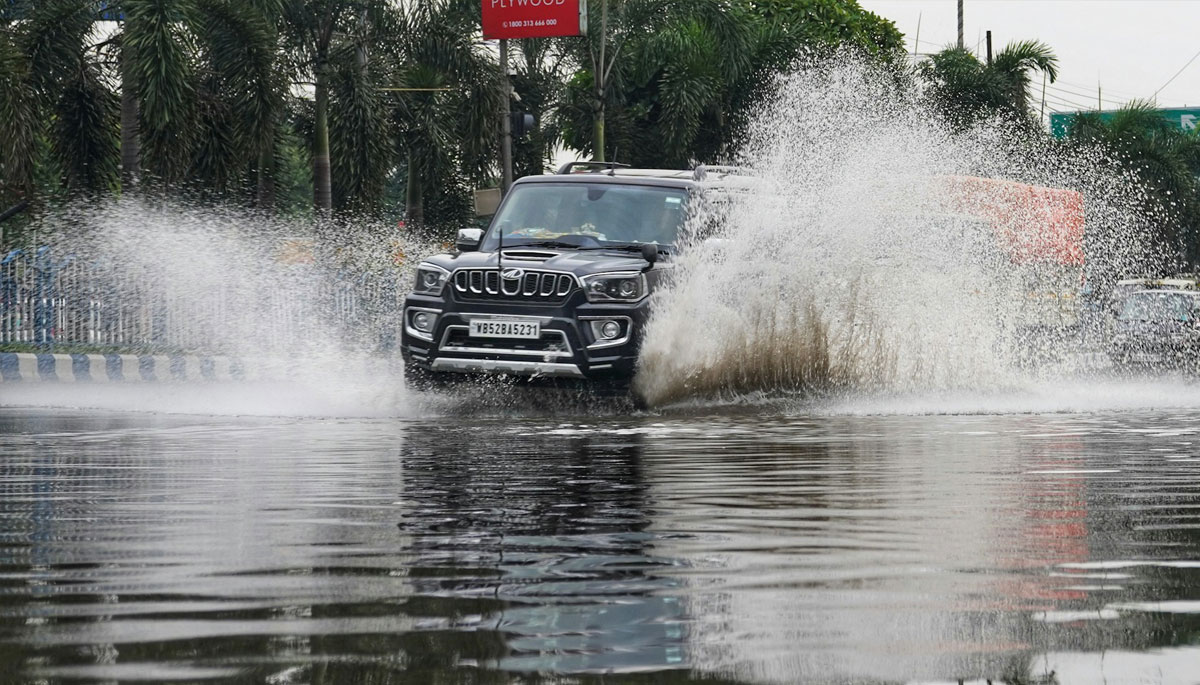Monsoon season brings heavy rainfall that can make driving treacherous. Follow this comprehensive driving guide to stay safe on the roads when navigating challenging Indian monsoon conditions.
Why Monsoons Make Driving Hazardous
The annual Southwest Monsoon usually arrives in June and lasts through September. These rains are critical for agriculture and reservoirs across India. However, the extreme precipitation also creates risky driving conditions.
Primary hazards include:
- Flooded streets and highways
- Reduced visibility
- Wet, slippery roads
- Vehicle breakdowns
- Traffic accidents
- Landslides blocking roads
Torrential downpours quickly overwhelm infrastructure like storm drains and sewers. Water then pools on roads, underpasses and low-lying zones. Attempting to drive through floodwaters is extremely dangerous yet preventable.
Thick sheets of rain also severely reduce visibility distance. Driving too fast for conditions heightens the chance of colliding with emerging vehicles, people or debris one failed to see ahead.
Finally, wet asphalt seriously reduces tire grip. Braking distances are longer, vehicles more prone to hydroplaning and skids. This only amplifies risks from poor visibility or rookie driving mistakes.
“We could not see more than 10 meters ahead due to extremely heavy rain when driving near Nainital last July. I pulled over and waited 2 hours for the storm to pass.” – Rahul S., Delhi
Getting caught in poor visibility or other dangerous conditions is no joke. Prepare properly and drive cautiously, as next sections explain.
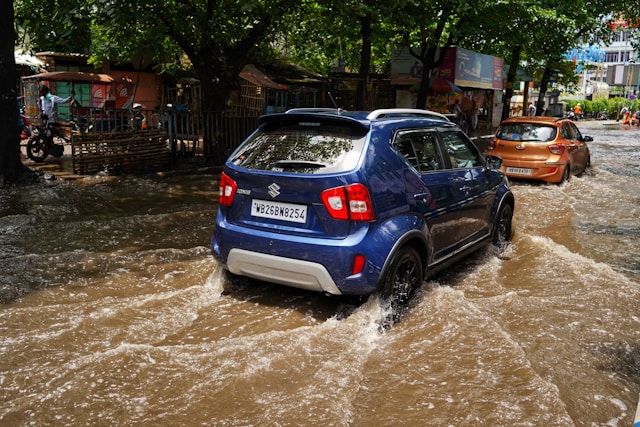
Regularly Check Weather Reports
Knowing weather conditions before heading out is crucial for safe driving. Monitor forecasts from:
- Local TV news channels
- National newspapers
- Weather apps like AccuWeather or India Meteorological Department’s Mausam app
- Radio announcements
Pay special attention to weather advisories like heavy rainfall warnings so you can better avoid flooded roads. Understanding terminology like heavy rain, very heavy rain, or extremely heavy rain also helps gauge just how intense the downpour will be.
The India Meteorological Department (IMD) divides rainfall intensity into several measurement buckets:
| Term | Rainfall Range |
|---|---|
| Light rain | 2.5 mm to 15 mm |
| Moderate rain | 16 mm to 64 mm |
| Rather heavy rain | 65 mm to 115 mm |
| Heavy rain | 116 mm to 204 mm |
| Very heavy rain | 205 mm to 300 mm |
| Extremely heavy rain | Over 300 mm |
So for example, “heavy rain expected this afternoon” tells you over 100 mm precipitation is forecast. That’s enough flooding risk to postpone unnecessary driving.
Apps like Weather Underground also show radar maps so drivers can visually track storm locations, intensity and movement. Knowing precisely when and where the rain bands will hit aids planning safe routes or delaying trips until the system passes.
The India Meteorological Department provides detailed monsoon forecasts including:
- Rainfall distribution
- Departure from average precipitation
- Cyclone track predictions
- 7-day projections
Tap this incredible data resource so you can smartly navigate monsoon driving in India.
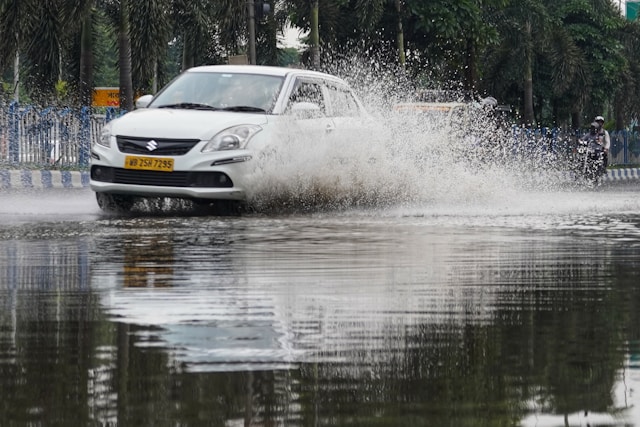
Vehicle Inspection & Maintenance
Subjecting your vehicle to intense monsoons is inherently taxing. Proper servicing before and during the rainy months reduces risks of getting stranded with mechanical problems.
Conduct a bumper-to-bumper inspection, checking:
Tires
- Tread depth using an indicator tool
- Inflation pressure
- Any cracks, bulges or embedded objects
Tires with adequate tread (3-4 mm) channel away more water to prevent hydroplaning. Proper inflation also maintains wet weather traction. Consider replacing worn tires with rainy-day models like CEAT SecuraDrive or Apollo Amazer.
Windshield Wipers
Old wiper blades smear and streak, severely hampering visibility. Install fresh rubber blades before the monsoon starts. Also refill the windshield cleaning fluid reservoir.
Filters & Fluids
- Drain old engine oil and install fresh 5W-30 or 10W-30 oil better suited for rainy driving
- Replace air, fuel and oil filters
- Top up brake fluid, automatic transmission fluid, coolant and power steering fluid reservoirs
Lights & Signals
- Headlights, taillights, turn signals
- Hazard flashers
Headlight lenses cloud over time. Frequently polish with toothpaste or wet sand to restore clarity and nighttime vision.
Handy pre-monsoon 20-point checklist
| System | Action Items |
|---|---|
| Tires | – Assess tread depth- Ensure proper inflation- Balance/rotate tires- Align wheels |
| Wipers | – Install fresh wiper blades- Refill wiper fluid |
| Fluids | – Change engine oil – Drain/replace transmission fluid – Top up brake/power steering fluid- Check coolant, refrigerant & battery electrolyte levels |
| Filters | – Replace air, fuel & oil filters |
| Brakes | – Check pad thickness- Adjust if needed- Bleed brakes |
| Lights | – Confirm all lights functional – Restore headlight clarity |
| Electronics | – Check horn, gauges, computer |
| Chassis Hardware | – Tighten loose bolts/fasteners<br>- Lubricate door hinges & locks |
| Emergency Gear | – Update first aid kit – Check flashlight batteries – Add emergency blankets, food |
This preventative care reduces risks of getting caught off guard by mechanical problems during extreme monsoonal precipitation.
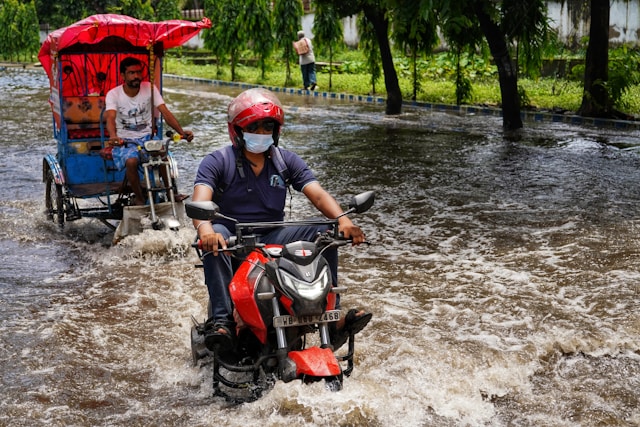
Adjust Driving Style
When roads turn wet and slippery, adapting one’s driving style is imperative:
- Obey speed limits – Moreover, reduce speed by 5-10 km/h below posted limits
- Increase following distance – Use 6-second rule during rains
- Avoid sudden acceleration/braking – Any abrupt speed changes heighten skid risk
- Use low beam headlights – Even during daytime they better illuminate road hazards
- Gently accelerate & turn – More throttle just spins the tires on slick surfaces
Also keep radio volume low so you can fully concentrate on weather conditions.
Beware Hydroplaning Risks
Hydroplaning involves losing contact between tires and road, essentially “floating” on water. Steering, braking and handling are extremely compromised.
To reduce hydroplaning risks:
- Keep speed moderate during heavy rain
- Inflate tires properly
- Align wheels accurately
- Replace worn tires
- Do not attempt sharp turns at speed
If you start hydroplaning, do not brake. Instead, ease off the gas pedal and make micro-steering adjustments aiming where you want the car to go once grip returns. Rick Steves, director of an advanced driving academy, notes:
“Very gentle steering inputs allow you to remain calm while hydroplaning occurs. Any slight steering change helps rotate the car where intended once the tires regain traction.”
Regain Control When Skidding
Vehicles lose traction and skid out much more easily on slick roads. Mastering proper techniques to recover control is invaluable:
- Look & Steer Where You Want to Go – Get eyes up scanning your escape path, not danger you’re avoiding! Make subtle steering inputs guiding the vehicle’s rotation in that intended direction.
- Avoid Overcorrecting – The instant traction resumes, hands-off any steering input allowing the wheels to straighten on their own. Too much input sends the vehicle skidding the opposite way!
- Be Smooth on Pedals – No sudden accelerator pumping or brake stabs. Smooth pedal work helps keep the car balanced and controllable.
Ideally, practice regaining control when safe, at low speeds on large empty parking lots with standing water. Perfecting slide recovery skills ahead of time gives confidence handling real-world emergencies on crowded roads.
Understeer skids (front wheels lose grip) and oversteer skids (rear wheels break traction) each require different techniques covered in advanced driving courses.
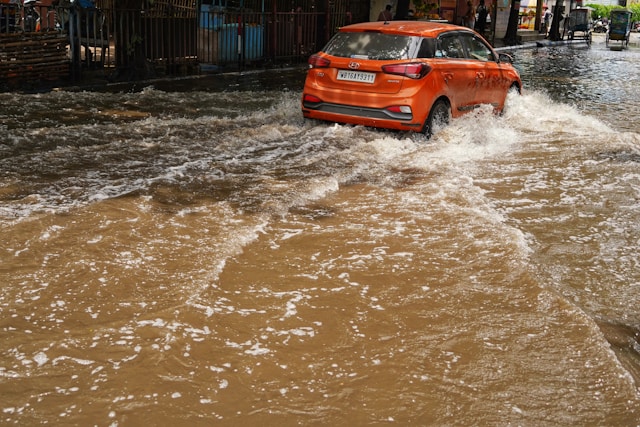
Drive Slowly in Low Visibility
Torrential downpours often severely reduce how far ahead drivers can see on the road. Take things slow when visibility goes down:
- Use low beam headlights to better illuminate the path ahead
- Partially open side windows which sometimes allows seeing better around windshield wiper blades
- Pull over if rain gets so heavy that forward visibility nears zero – it’s pointless risking a serious accident attempting to move forward essentially blind! Activate emergency flashers when stopped.
- Match speed to actual sight distance, not faster posted speed limits.
Avoid Flooded Streets & Underpasses
Some extreme monsoonal precipitation events dump immense volumes of water that floods roads, underpasses and even entire villages.
Before driving through pooled water, judge depth and flow intensity. Turn around instead of proceeding if:
- Standing water seems deeper than the road itself
- Current looks strong enough to push the vehicle
Remember, it’s better arrive late than never!
Hazards when driving through flowing water:
- Depth is likely much deeper than it appears
- Current could sweep away the vehicle
- Engine damage ingesting water
If you unexpectedly encounter deep floodwaters across your path, the best tactic is waiting for it to recede or calling for help. Abandon the car if needed rather than confront rapidly moving water.
“Turn around, don’t drown” is wise advice when monsoon flooding surges beyond expectations. Play it safe.
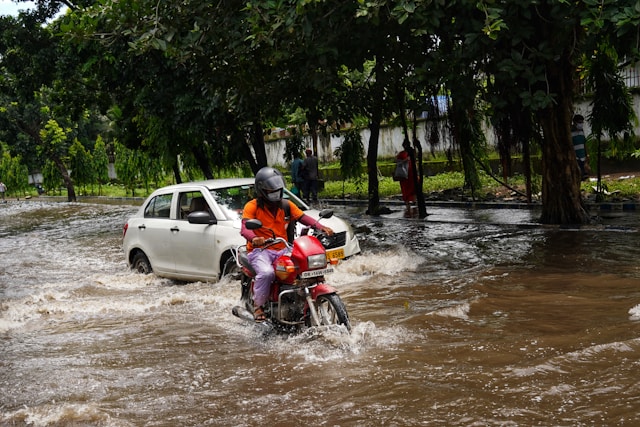
Prepare an Emergency Supply Kit
Carrying the right gear provides peace of mind when heading out into intense storms. Useful items include:
- First aid kit
- Drinking water
- Non-perishable snacks
- Emergency blankets & poncho
- Sturdy flashlight with extra batteries
- Flares
- Car phone charger
- Small shovel and traction pads
Having supplies to manage unexpected flooding, accidents or breakdowns reduces risks if trapped overnight.
Also tell someone your destination route and expected arrival time before embarking so they can send help if you go missing.
While monsoonal storms can present driving hazards, taking proper precautions detailed in this guide helps navigate conditions safely. Show respect for heavy rain by slowing down, avoiding flooded zones and maintaining situational awareness at all times. Prep work and preventative maintenance reduces risks before heading out. Finally, continually refine advanced driving skills so you can skillfully handle slick surfaces or low traction scenarios.
Stay safe on the roads this monsoon season!

